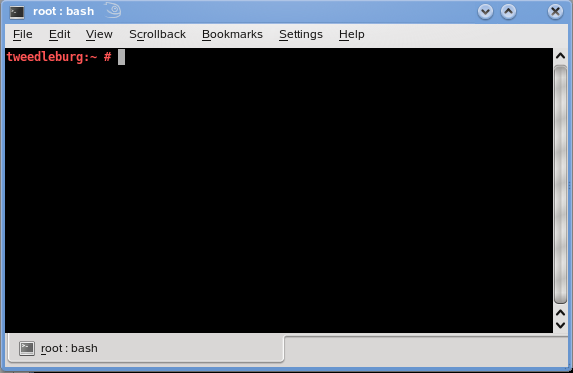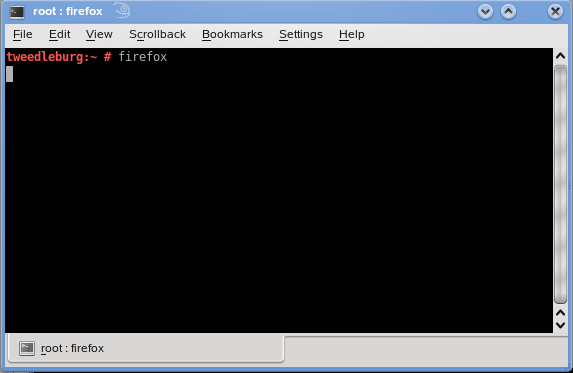Difference between revisions of "Your first steps on Linux"
imported>WikiSysop |
imported>ThorstenStaerk |
||
| (33 intermediate revisions by 7 users not shown) | |||
| Line 6: | Line 6: | ||
[[Image:Konsole.png]] | [[Image:Konsole.png]] | ||
| − | The background can be black, white, green, any color. So can be the font. "tweedleburg" is my hostname, it can be different for you. Anyway, most important is you can write into it. | + | The background can be black, white, green, any color. So can be the font. "tweedleburg" is my hostname, it can be different for you. Anyway, most important is you can write into it. What you write are commands to be executed. For example the command '''firefox''' will start the firefox browser: |
| + | |||
| + | [[Image:Konsole-firefox-command.png]] | ||
| + | |||
| + | From now on, we will no longer use graphical files to show you what to do, but a box like the following: | ||
| + | tweedleburg:~ # firefox | ||
| + | ok? Super, let's go on. You can also auto-complete your command. Type | ||
| + | firef | ||
| + | and then the tabulator key once or twice. The system will show you all available commands starting with firef or complete your command automatically. | ||
| + | |||
| + | = Get help = | ||
| + | To get help you can chat with other Linux users about problems. Everyone who asks questions can at the same time answer. Go to http://webchat.freenode.net/ and join channel #suse for SUSE Linux questions. | ||
| + | |||
| + | = File commands = | ||
| + | You can list the files in your directory using the command '''ls''', for example: | ||
| + | tweedleburg:/etc/apache2 # ls | ||
| + | charset.conv httpd.conf mod_autoindex-defaults.conf mod_status.conf ssl-global.conf ssl.key vhosts.d | ||
| + | conf.d listen.conf mod_info.conf mod_userdir.conf ssl.crl ssl.prm | ||
| + | default-server.conf magic mod_log_config.conf mod_usertrack.conf ssl.crt sysconfig.d | ||
| + | errors.conf mime.types mod_mime-defaults.conf server-tuning.conf ssl.csr uid.conf | ||
| + | [[ls|learn more about ls]] | ||
| + | |||
| + | You can find out how much space is available on your disk by typing df -h (disk free, human readable): | ||
| + | tweedleburg:~ # df -h | ||
| + | Filesystem Size Used Avail Use% Mounted on | ||
| + | /dev/sda1 917G 205G 667G 24% / | ||
| + | udev 2.0G 164K 2.0G 1% /dev | ||
| + | /dev/sdb2 294G 274G 5.4G 99% /mnt/sdb2 | ||
| + | On the directories beneath the root ("/"), there are 667 GB free. But under /mnt/sdb2, there are only 5.4 GB available. | ||
| + | |||
| + | = install software = | ||
| + | You will normally download software in the form of tarballs. Tarballs are files typically ending in .tar.gz or .tar. You must [[unpack]] them to use them. More info: | ||
| + | * [[unpack]] | ||
| + | * [[install]] | ||
| + | |||
| + | = Set up a printer = | ||
| + | Setting up a printer does not work inside a virtual machine (that is, it does not work without tricks). Anyway, if your Linux is running on real hardware, set up your printer using | ||
| + | yast2 printer | ||
| + | |||
| + | = Create an "ll" alias = | ||
| + | Often-used console [[commands]] can be made easier by setting sensible alias-names for them. This is a matter of taste and heavily depends on what commands you use and what aliases you are used to. For example I am used to typing ll and getting the output of ls -ltr, the long file list in the directory. | ||
| + | To do this, enter in your console: | ||
| + | alias ll="ls -ltr" | ||
| + | * To have this in future [[logIn shells]], create a file /etc/profile.d/ll.sh containing this line. | ||
| + | * To have this in future non-login-shells, add the command to /etc/bash.bashrc | ||
| + | |||
| + | = Create an "ssh" alias = | ||
| + | When you [[control a computer via network]] using [[ssh]] you may want to call a graphical program like [[ksar]]. Then you will miss that you did not use ssh -Y. To avoid this, make sure every call to ssh is a call to ssh -Y by creating an alias: | ||
| + | alias ssh="ssh -Y" | ||
| + | * To have this in future [[login shells]], create a file /etc/profile.d/ll.sh containing this line. | ||
| + | * To have this in future non-login-shells, add the command to /etc/bash.bashrc | ||
| + | |||
| + | = Turn off system beep = | ||
| + | In an office you will not want your computer to beep every now and then, so [[turn off system beep]]. | ||
| + | |||
| + | = Lock screen on PAUSE key = | ||
| + | When you take a break at work you will want to lock your screen. I set my PAUSE key to lock the screen. [[set your PAUSE key to lock the screen|Here is how]]. | ||
| + | |||
| + | = See also = | ||
| + | * [http://librenix.com/?inode=4052 an introduction to Linux in 10 commands] | ||
Latest revision as of 10:57, 19 September 2013
Ok, so you have managed to install Linux on your computer. You have started it and logged in. You now wonder what comes next.
Contents
Open a console
A console is text-based window where you can enter commands for your Linux. To start a console, type ALT_F2 and enter konsole. You should see a screen like this:
The background can be black, white, green, any color. So can be the font. "tweedleburg" is my hostname, it can be different for you. Anyway, most important is you can write into it. What you write are commands to be executed. For example the command firefox will start the firefox browser:
From now on, we will no longer use graphical files to show you what to do, but a box like the following:
tweedleburg:~ # firefox
ok? Super, let's go on. You can also auto-complete your command. Type
firef
and then the tabulator key once or twice. The system will show you all available commands starting with firef or complete your command automatically.
Get help
To get help you can chat with other Linux users about problems. Everyone who asks questions can at the same time answer. Go to http://webchat.freenode.net/ and join channel #suse for SUSE Linux questions.
File commands
You can list the files in your directory using the command ls, for example:
tweedleburg:/etc/apache2 # ls charset.conv httpd.conf mod_autoindex-defaults.conf mod_status.conf ssl-global.conf ssl.key vhosts.d conf.d listen.conf mod_info.conf mod_userdir.conf ssl.crl ssl.prm default-server.conf magic mod_log_config.conf mod_usertrack.conf ssl.crt sysconfig.d errors.conf mime.types mod_mime-defaults.conf server-tuning.conf ssl.csr uid.conf
You can find out how much space is available on your disk by typing df -h (disk free, human readable):
tweedleburg:~ # df -h Filesystem Size Used Avail Use% Mounted on /dev/sda1 917G 205G 667G 24% / udev 2.0G 164K 2.0G 1% /dev /dev/sdb2 294G 274G 5.4G 99% /mnt/sdb2
On the directories beneath the root ("/"), there are 667 GB free. But under /mnt/sdb2, there are only 5.4 GB available.
install software
You will normally download software in the form of tarballs. Tarballs are files typically ending in .tar.gz or .tar. You must unpack them to use them. More info:
Set up a printer
Setting up a printer does not work inside a virtual machine (that is, it does not work without tricks). Anyway, if your Linux is running on real hardware, set up your printer using
yast2 printer
Create an "ll" alias
Often-used console commands can be made easier by setting sensible alias-names for them. This is a matter of taste and heavily depends on what commands you use and what aliases you are used to. For example I am used to typing ll and getting the output of ls -ltr, the long file list in the directory. To do this, enter in your console:
alias ll="ls -ltr"
- To have this in future logIn shells, create a file /etc/profile.d/ll.sh containing this line.
- To have this in future non-login-shells, add the command to /etc/bash.bashrc
Create an "ssh" alias
When you control a computer via network using ssh you may want to call a graphical program like ksar. Then you will miss that you did not use ssh -Y. To avoid this, make sure every call to ssh is a call to ssh -Y by creating an alias:
alias ssh="ssh -Y"
- To have this in future login shells, create a file /etc/profile.d/ll.sh containing this line.
- To have this in future non-login-shells, add the command to /etc/bash.bashrc
Turn off system beep
In an office you will not want your computer to beep every now and then, so turn off system beep.
Lock screen on PAUSE key
When you take a break at work you will want to lock your screen. I set my PAUSE key to lock the screen. Here is how.

